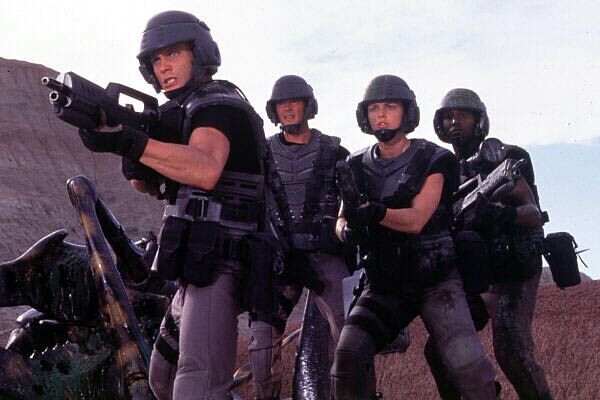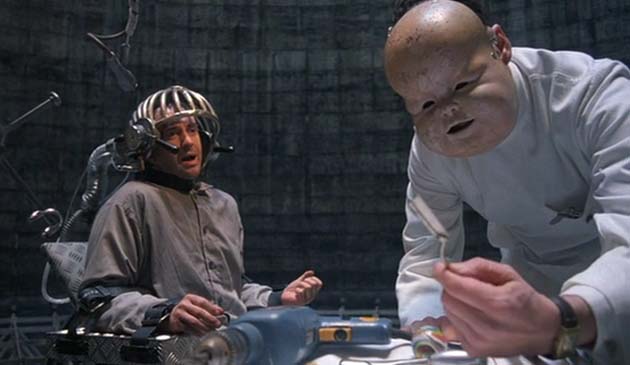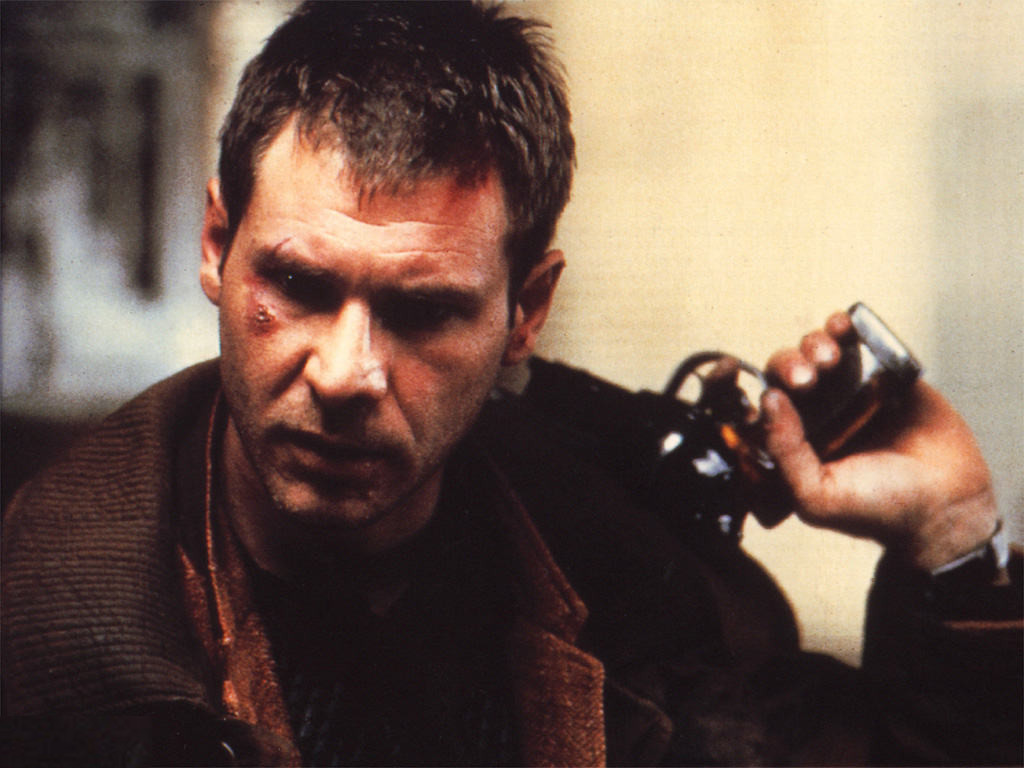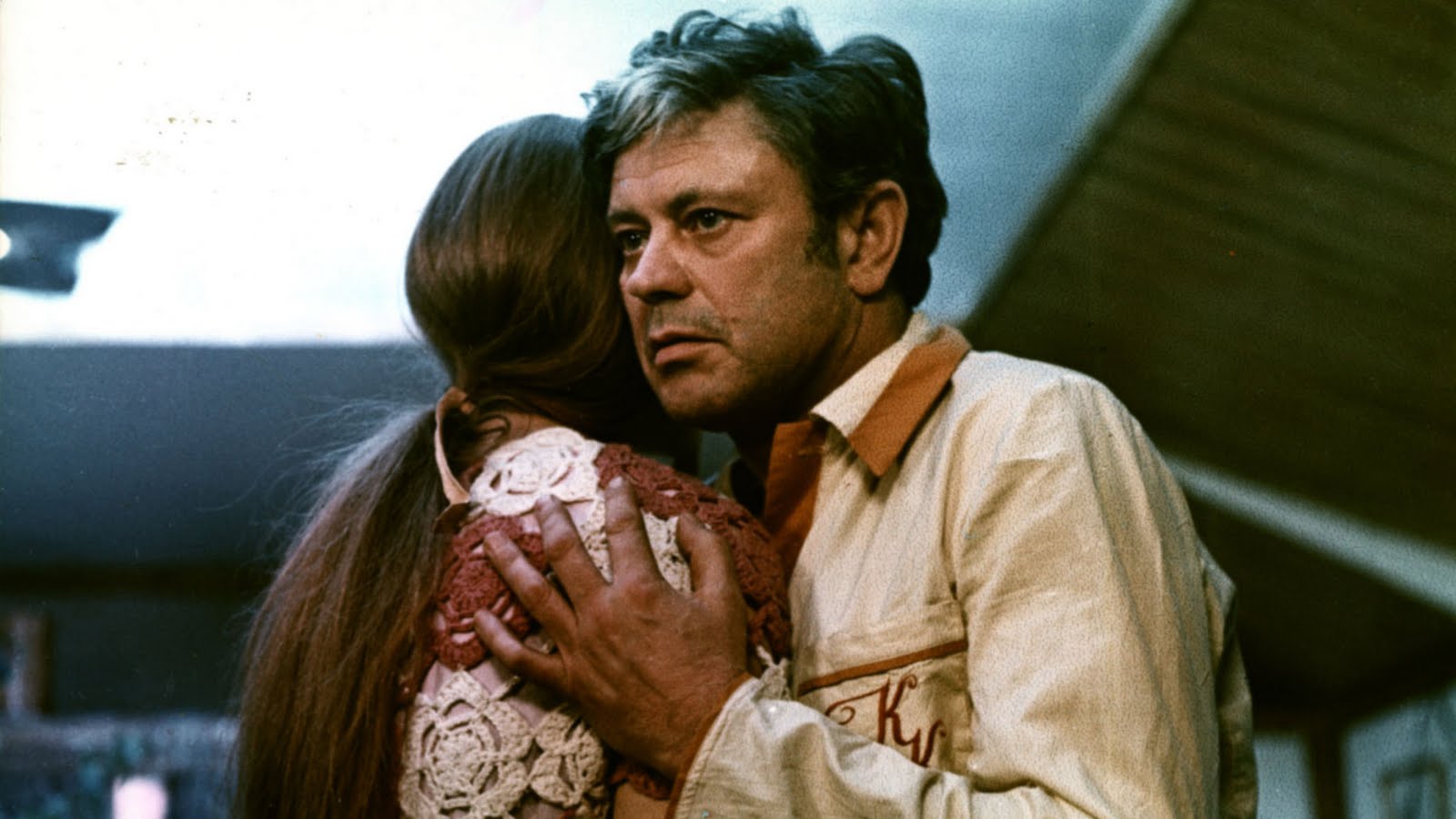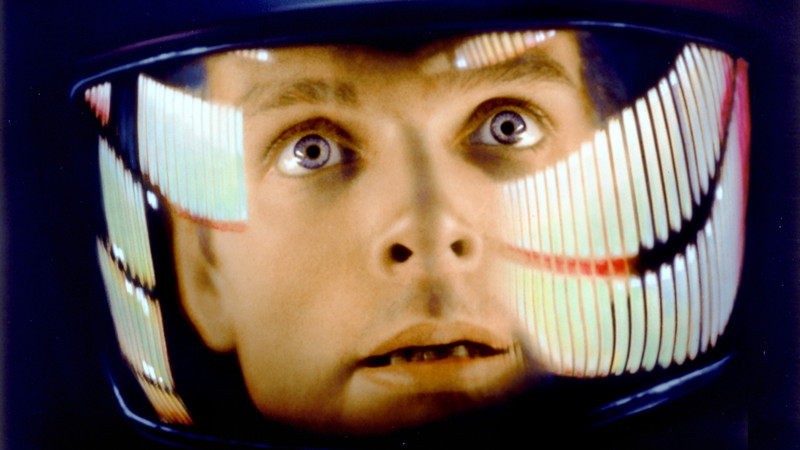5. Starship Troopers (1997)
Robert A. Heinlein was a “Big Three” science fiction author with an unusually distinct range of style. Many of his early stories were action and adventure stories that were set in space, and often followed heroic characters on their quests. Starship Troopers, originally a magazine serial titled Starship Soldier, originated near the end of this first phase of his writing. His later books, such as Stranger in a Strange Land, explored a greater range of topics in philosophy and ethics.
Troopers is a hard-boiled story about war, told through the voices of soldiers that are battling a fictitious alien race, and also an examination of the reasons for war and how soldiers can fulfill civic responsibility. Partial inspiration for some of Heinlein’s views in the book may been formed during his time in the navy during World War II.
The movie version is an explosive action story and drama about a young man’s quest to fulfill his life’s purpose and become strong enough to impress a woman. One difference from Heinlein’s story is that the movie uses dark humor to create the effect of satirizing the war plot, in a way reminiscent of Full Metal Jacket, although at times the jokes seem centered on the outlandish plot of fighting bugs in and of itself.
The battle scenes between the troopers and the bugs are the major highlight of the movie. State-of-the-art special effects for the time create massive beasts that look half spider, half praying mantis, which are quick to slice up their opponents in a variety of gory ways. The troops join the fight with machine guns and grenades, but later come to use airstrikes when they become outnumbered.
Starship Troopers was directed by Paul Verhoeven, who had previous experience with violent action dramas in directing RoboCop.
4. Brazil (1989)
George Orwell’s political fiction 1984 was groundbreaking for science fiction, and practically invented the dystopian category. Its influence is palpable today in a variety of stories about utopias-gone-amok, totalitarian regimes, technological sprawl, post-apocalyptic scenarios, cyberpunk, and neo-noir pessimism.
Orwell’s novel described a future devoid of emotion or pleasure, where thought police and harsh laws repress a population into obedience or listless acceptance of the way things are. Chance circumstances in the life of the apathetic hero get him entangled in outlawed activities that show him new sides to life, as well as put his existence into peril.
Although many popular films have been created which mirror aspects of 1984 – such as V for Vendetta, Island, and Equilibrium – direct adaptations have been rare and not always as well received. Terry Gilliam’s Brazil, despite also adding a few twists to the story, is significant for authentically capturing the full essence and atmosphere of 1984 in an appropriate form – dark humor.
Gilliam is a film creator famed for many things, from the zany animated shorts for Monty Python that inspired South Park, to surreal, imaginative films like Time Bandits, to the bizarre, disturbing atmosphere he later created for in films like 12 Monkeys and Fear and Loathing in Las Vegas.
With Brazil, Gilliam tells the story of a hopeless, pathetic man who has never experienced freedoms such as love finally getting a chance to break out of his shell. Throughout the film, the dark, menacing, and box-like city the man hero lives in melts away into dream sequences in which he imagines himself flying through clouds in angel garb or fighting off giant samurai with a sword.
Brazil’s introduction of humor into the 1984 theme ends up working perfectly, and makes what might have been an otherwise depressing story feel like an energetic musical.
3. Blade Runner (1982)
Philip K. Dick, also known as P.K.D., was a prolific science fiction writer on the neo-noir dystopian theme whose works explored topics such as totalitarian uses of technology, artificial intelligence, virtual reality, altered states of consciousness, and contact with alien or supernatural forces. Examples of movies based on his stories include Total Recall, Minority Report, A Scanner Darkly, Next, Screamers, Paycheck, Imposter, and The Adjustment Bureau. One of his most acclaimed novels was Ubik, which dealt with the theme of contact with the dead and virtual reality.
Dick’s book Do Androids Dream of Electric Sheep? is a story that takes place in a future world where human replicants, androids with human-like personalities, are routinely treated as property or destroyed. The title also refers to the fact that in the story, a previous nuclear event has left Earth with little remaining animal life, left to be replaced by artificial animals.
The main character is a married bounty who is given the task of investigating replicants that must be destroyed. He loses sight of his task in the face of their human-like qualities, especially when a female replicant has sex with him. He makes a rogue decision to protect the replicant, who feels that she is a real human, placing him in danger for breaking a societal rule.
Director Ridley Scott, of previous fame for Alien, headed the acclaimed movie version, which he personally felt was one of his most creative contributions to film. Harrison Ford played the main character, having come from prior science fiction and fantasy fame himself for his roles in Star Wars and Indiana Jones, and the female android character was played by Sean Young.
Blade Runner has been praised for its engaging dark atmosphere, gritty action and storyline, and philosophical themes. It quickly became a cult classic in science fiction circles, and increasingly with time, a mainstream film classic as well.
2. Solaris (1972)
Solaris, written by Stanisław Lem, is by no means an ordinary science fiction story. Differing greatly from invasion tales or action epics, it uses an unconventional plot, style, and characters. The story follows astronauts inhabiting a space station on an alien planet thought to be lacking in life.
Much of the buildup of the story is slow, although highly detailed. In a style reminiscent of Arthur C. Clarke or Michael Crichton, Lem describes the alien planet and space technology with a scientific accuracy that helps make the story feel like real events to readers.
A great deal of the book also delves into the psychology of the characters, including their thoughts and experiences living in near isolation, as well as their memories of the past. As time drifts on, the protagonist starts to feel ill effects of his stay on the planet, including unexplained thoughts, sensations of communicating with another intelligence, and hallucinations. The rest of the story deals with this mystery, asking readers whether there is life on the planet or it is simply a perceptual illusion.
Solaris has been adapted for film a few times, most recently in a movie by Steven Soderbergh in 2002, which starred George Clooney. The adaptation that most accurately captured the style and feel of Lem’s original, however, was the 1972 film directed by Andrei Tarkovsky.
Tarkovsky was a Russian filmmaker who utilized unconventional filmmaking and storytelling techniques to create films characterized by spiritual and metaphysical themes. His work on films including Andrei Rublev, Mirror, and Stalker helped secure his status as one of the greatest filmmaker of all time.
The Polish writer Lem had a similarly philosophical style and subject range in his own discipline of literature, making his story a great choice for Tarkovsky. The nearly three-hour movie has a pace that may seem brooding at the start, but like Stanley Kubrick’s 2001, the cinematic effect that builds up is worth waiting for.
1. 2001: A Space Odyssey (1968)
2001: A Space Odyssey is a giant in both science fiction literature and film. The 1968 joint release of the book and film was a rare case of close cooperation between an author and director on productions that nearly mirrored each other in quality.
Arthur C. Clarke was an author of science fiction stories that were compelling in part for their attention to detail and realism with respect to the technology of space travel. He was known as one of the “Big Three” science fiction authors of his time, along with Isaac Asimov and Robert Heinlein.
Stanley Kubrick, the legendary film director with a habit of basing movies on written works, was a natural choice to direct the motion picture.
2001 was the first part of a Space Odyssey book series by Clarke, which had a partial basis in his earlier short stories “The Sentinel” (1948) and “Encounter in the Dawn” (1953). Beginning in the first novel, the series explores humankind’s ascent into space with the birth of modern aerospace technology, questions about human identity that are raised by the development of machines with artificial intelligence, and general reflections about the past and future of humanity.
Both the film and novel are epic in scale and take place over expanses of time. Much of the story takes place aboard a spaceship that is manned by astronauts and an artificial machine, known as HAL. In part to capture aspects of the experience of being in space such as isolation, many sequences in the film proceed without action or dilemma, although the plot climax builds during the second half.
The film remains as one of Kubrick’s most acclaimed works, despite lacking the adrenaline pace of Full Metal Jacket or A Clockwork Orange. Instead, it uses a more dramatic tone, bearing a closer resemblance to his period piece film Barry Lyndon. Clarke’s book is also sprawling and not for quick entertainment alone. In these respects, the 2001 story seems to demand that audiences receive it as a serious piece of art, and one worth investing time in digesting.
